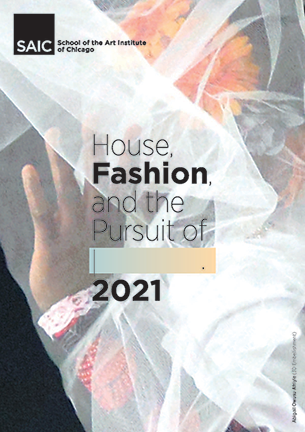Chair Letter
House, Fashion & the Pursuit of __________
Dear Students, Faculty and Friends of the SAIC Fashion Department,
Welcome to the Fashion 2021 Virtual festival celebrating the achievements of all our students and classes in the fashion department!
It has been an extraordinary academic year; one, which we will share with you the way we shared much this past year: virtually. May 14, 2021 marks the launch of a new department website which gives each student their own showcase. On this day we also premiere a suite of fashion films created by the graduating senior class of 2021. We are delighted to toast the awardees, and celebrate all our students, for their amazing pursuits through creativity, innovation, and resilience.
Senior Video
House, Fashion & the Pursuit of __________
Scholarships and Awards
SAIC Fashion 2021
Bodybuilder Awards
Bodybuilder award for accessories, footwear & headwear
Bodybuilder award for garment and wearables
Bodybuilder award for 2D illustration, photography, and digital media
Bodybuilder award for time-based and performance
Bodybuilder award for sculpture/ installation
Bodybuilder award for writing
Honorable mentions
Sophomore Awards
The Marcia and Lester Novy Memorial Scholarship
William V. Mollihan Scholarship
Fashion Council Sophomore Scholarship
Morris & Rose Goldman Scholarship
Gloria Omi Tsien Scholarship
Leora Comer Pogue Scholarship
Honorable mentions
Junior Awards
Fashion Council Junior Scholarship
Perry Ellis Scholarship
Ungaro Scholarship
The Shirley G. Schnackenberg Grant
Honorable mentions
Senior Awards
Cornelia Steckl Fashion Fellowship
Luminarts Undergraduate Fellowship
Fashion Council Senior Award
Diversity & Inclusion Award
Supima Cotton NYFW Participant Award
Honorable mentions
Graduate Awards
Fashion Council Graduate Fellowship
NicNac Fashion Award
Facility x Tiffany Award
Next Decade Faculty Award
Luminarts Graduate Fellowship
- Abigail Afriyie
- Alex McDermott
- Ali Kushner
- Allison Pasquesi
- amanda germolec
- Andrew Bohlin
- Khoi Le
- Rose Okamura
- Ari Michak
- Av Grannan
- Bona Chun
- Bora Kim
- Brennan Brower
- Bridget Barone
- Caeli Harris
- Carly Trujillo
- Caroline Chlipala
- Caterina DeRousse
- Charlotte Holly
- Chia-Yu Lin
- Chiyuan Sun
- Darius
- Dawson O’Keefe
- Eliana Batsakis
- Ellington Bramwell
- Faviola Anaya Esquivel
- Fernanda Carvalho
- Frida Paola Benitez
- Gianna Dorothy Gaspar
- Goldie Schmiedeler
- Grant Karpin
- Hayden Wentworth
- Roy Zhu
- Hope Corrine Vaughan
- helen.
- Abigail Koo
- Isaac Couch
- Iyomi Ho Ken
- Jackie Schmidt
- JiaJia Bao
- Elsa Shao
- Jiayi Huang
- Jiayu (Sherry) Hu
- J.uleda
- Boulder
- Julie Baker
- Kendall Schamel
- Kalia-Catherine Sky
- Laura Arieli
- Leslie López Lizarraga
- LEYANG LI
- Lily Parker
- Milly (Lingjue Huang)
- Lorea Román Matosas
- Margaux Laibe
- Maria Jaxiry Aguilar
- Mariana Espinosa
- Marina Dissinger
- Matthew Cook
- Megan Wong
- Melis Vural
- Mette Ulland
- Michela Colognese
- Mila
- Musa Ghaznavi
- Myra Chung
- Nicky Lace
- Nick D’Alessandro
- Nic Holmberg
- Nina Liu
- Olivia Comai
- Ana Wu (Qinrou)
- Ra Dahan
- Rajvi Jaxay Shah
- Rhea Singh
- Rose Bizub-Rodriguez
- Rever Li
- RUYI QIAN
- Sam Fissell
- Sanding
- Sino Park
- Shawn Huang
- Shelby Hubbard
- Shijie He
- Kathy Lao
- Tara Froehlich
- Tianjian Xiao
- Sky Shi
- Tiffany “Moon” Marie
- Ting Deng
- Tirzah Lawson
- Matilda ( Tongying) Liang
- Troy Derks
- Vanessa Duran
- Veronica Wakefield-Young
- Xiaofeng ZHOU
- Ellie Tie
- Victoria(Xinyue) Bi
- Xinyue(Bella) Chen
- Lainy Ya Liu
- Lainy Ya Liu
- Yan Yang
- Yui Chen
- Yi Cui
- Yichen Li
- Ying Wang
- Yitong Zhao
- Yiyan Wang
- Yuri Anne
- MARINA CHEN 陈禹瑄
- Zoë Roze
- Zoe Johnson
